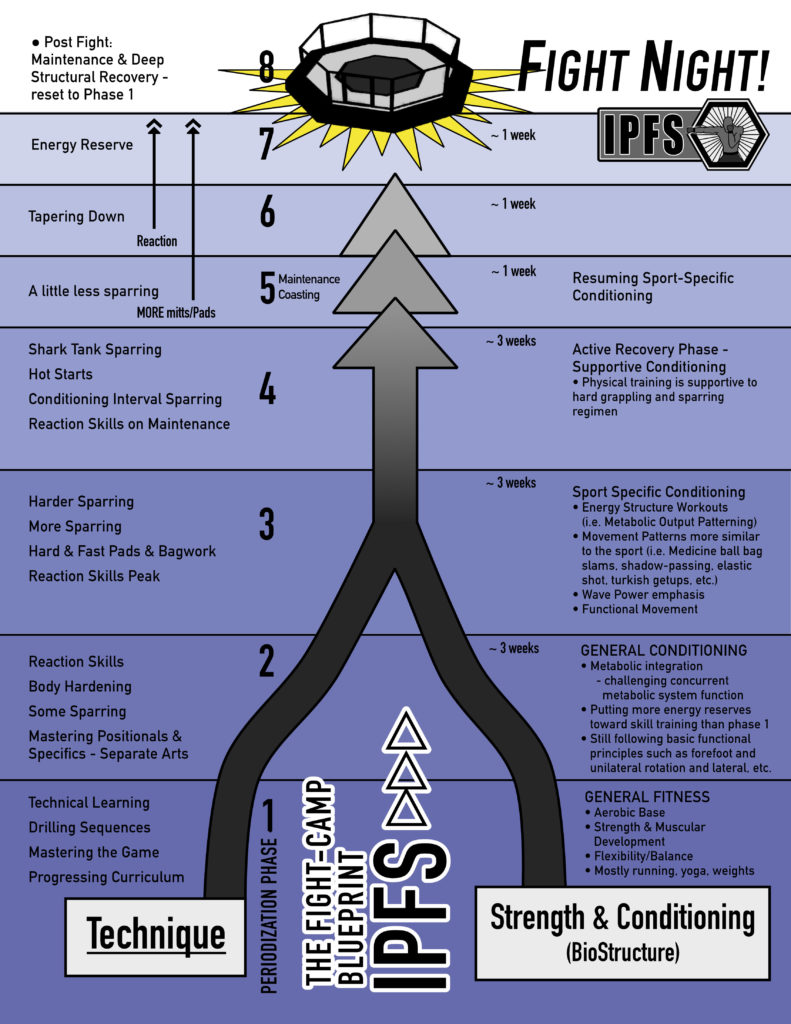This diagram is a loose template for how a first time MMA athlete should approach their first fight, starting 12 weeks out or more. An experienced returning fighter who stays in relatively good shape should only need a 4-6 week training camp to be in peak physical and technical level for an event, and the ultimate lifestyle would be always being ready to compete on short notice (& the key there would be injury prevention to maintain peak physical condition long term.)
It’s much easier to maintain peak physical condition for a short period, then go through a post-fight protocol of preventatively recovering from potential injury issues and re-focusing on technical learning from the situations that happened in your fight. The whole point of competing is to learn from experience, so if you don’t go over the fight situations while it’s still fresh in your brain you end up kind of missing the whole point…
As far as this template – the most important takeaways here are that your “general” strength and cardio training (basic weight lifting, running/cycling, etc…) are taking place LONG IN ADVANCE of the actual fight training, so you have the results “in the bank” and the focus is on doing the actual skills of fighting, ie striking and grappling. That way your physical energy and recovery are all going into the real skills necessary for the fight. Trying to get in shape at a baseline level during the fight camp (ie trying to do a lot of weight lifting and running on top of striking and grappling,) is going to challenge your recovery. You’ll find it hard to focus on sharpening your skills if you’re showing up to fight training sore and tired.
Furthermore, it’s the same with your technical development:
You need to have been doing the fundamentals programs LONG IN ADVANCE so that you’re not trying to learn how to fight as the match date approaches, that’s just silly. Your defense, escapes, movements, everything needs to be dialed in fundamentally going INTO the training camp so that you DON”T TAKE HEAD DAMAGE in SPARRING before the match. If your technique is there through our program, you should be able to spar WITHOUT taking a lot of damage. This allows you to SPAR MORE, safely, and be better on fight night. Our JiuJitsu system similarly allows you to control ground situations defensively, so that you don’t take damage on the ground.
Taking damage in sparring, on our team we call the “doing the opponent’s job for them,” because it weakens your chin and increases the likelihood of getting knocked out in the fight just as much as under-training sparring and being gun-shy in the event. The only real solution is to have your technique (especially defense,) and strength/cardio in place AT THE BEGINNING of the training camp, and focus on the skill of fighting with the S&C tapering down as you get closer to the fight.
We have a hard-sparring “push period” around 3 weeks out, into the weekend going into the last 2 weeks, then one more conditioning/strength push while we recover from sparring, then the last week is just focusing on recovery, range of motion (flexibilty,) and putting the finishing touches on your game plan.
In the last week it’s important to train less than you want to, so that you build up an energy reserve for fight night. Low volume, focused on speed, and low impact cardio for active recovery are all we do that week aside from stretching, rolling out, and drilling techniques for our game.
If you’re reading this as an aspiring athlete, if you haven’t already been through the fundamentals programs for striking and grappling, built up your baseline strength and aerobic base, you have no business trying to fight. Go to the classes and work on building your foundations!



